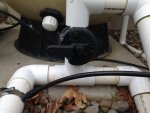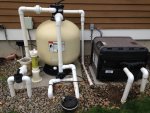Hi all. Been a long pool-less winter! We have what seems to be a 2 way valve on the pipe that runs from our filter to the heater lines and then back to the pool. As in the attached pics, the off/closed tab only points to the right (towards the heater) and down (towards the return line to the pool). I'm not sure why the builder installed this as I don't know why I'd not want to send water to my heater, but my question is this (as I always ask myself this each year); which is the proper run position? I would think its with the off/closed tab pointed to the right so that it is not pointing towards a pipe (and stopping flow), as if it's pointed in the other position downward it would stop water from flowing from the heater back to the pool, yes? Thanks for the help on a remedial question!
Simple valve flow question
- Thread starter DOMO
- Start date
You are using an out of date browser. It may not display this or other websites correctly.
You should upgrade or use an alternative browser.
You should upgrade or use an alternative browser.
The black round thing with the gauge looks like an in-floor cleaning system. From what little I can see of the whole plumbing layout, I think that valve gets turned up to block the T and send all the flow to the infloor cleaner.
Hi. Thanks for the prompt reply. The black dome thing is actually a Paramount Swingjet component, it switches the flow every 2 minutes to the 3 wall jets on one side of the pool to the other side. Essentially, the water should flow from the filter to the heater and back to the Swingjet dome to the pool.
I’m not sure, but I think that the valve acts as a heater bypass. When the off tab points down, water is forced through the heater via the T above the valve and returns through the lower right pipe.
When the valve is open, the water bypasses the heater loop.
The valve can also be partially closed to control the amount of flow going to the heater.
Be careful because the heater has a pressure switch and not a true “Flow” switch and it can fire with no flow if the bypass is open.
Note: I can’t be sure because all of the plumbing is not visible.
When the valve is open, the water bypasses the heater loop.
The valve can also be partially closed to control the amount of flow going to the heater.
Be careful because the heater has a pressure switch and not a true “Flow” switch and it can fire with no flow if the bypass is open.
Note: I can’t be sure because all of the plumbing is not visible.
Hi. Thanks for the reply. Yes, my understanding is that the valve's purpose is to bypass the heater loop if necessary (however, we never do). What you're saying about when it's pointed down (closed/off) makes sense as it would force water to go 'right' at the T through the heat loop, yes? But when the valve's close/off position is pointed to the right (the only other position it can go), I'm confused on how that would stop water from flowing to the heater? Wouldn't water still flow to the right (to heater) at the T AND flow directly downward to the returns?
Water, like electricity, follows the path of least resistance. With the valve open, there's no reason for the water to go through the heater loop. The pressure at the line going to the heater is almost exactly the same as the pressure at the line coming from the heater. There might be a little flow, but it won't be much.
Understood. Just to be clear, when you say 'valve is open', which position do you mean? What is confusing to me is that there are only 2 positions and they are not at the T, and one of which points 'closed' not directly at a pipe. Apologies for being so dense (but the way they plumbed this does not seem intuitive)!
Pool Clown
In The Industry
I'll bet that the infloor runs all the time and has no valve controlling water to it. A lot of builders just automatically put a by-pass on the heater. Your 1 hp pump does not move enough water to dictate one of these for your heater. You may as well leave the handle pointing up, diverting all the water to the heater. and get on with your spring!
Hi. Thanks for the reply. So we don't have an in floor cleaner, the dome in the ground is a timing diverter for our returns (6 swingjet wall returns, 2 zones). Funny you should mention leaving it' pointed up', as the valve doesn't point up, only 2 stop positions, right and down. This is part of the confusion. So, my question remains: if the valve is pointed with the 'close/off' pointed down, is that 'closed' and diverts all water to the heating loop and then to the swingjet for the returns? Or if the valve is pointed with the 'closed/off' to the right (but not directly at a pipe), does that divert all the water to the heater loop, etc.?
Remove the stops from the holes and you can point it anyway you want. The tab opposite the handle should say off. The pipe it points to is off.
Pool Clown
In The Industry
Up or down, doesn't matter. Either way closes the valve and forces water to the heater. Opening the valve (right) would let water by-pass the heater thus reducing flow through it.
If you had say a 2 hp or in some cases even a 1 1/2 hp pump could achieve a flow rate that would surpass the maximum flow rate on the heater and would begin to strip or scour the copper from the heaters' exchanger. So that's the reason for the by-pass valve, to let some of that flow rate bleed off (if needed) through the valve, saving the heater.
If you had say a 2 hp or in some cases even a 1 1/2 hp pump could achieve a flow rate that would surpass the maximum flow rate on the heater and would begin to strip or scour the copper from the heaters' exchanger. So that's the reason for the by-pass valve, to let some of that flow rate bleed off (if needed) through the valve, saving the heater.
pooldv, understood, I guess my point/question was more to why they did not set it up to be able to point the valve straight up.
Poolclown, that's very helpful, thanks. Sounds like the best position would be pointed to the right, if I had a larger pump, but because I only have a 1 hp pump, there's no potential harm to the heater by pointing the valve down (closed) and forcing all flow to the heater, yes?
Had a pool company here yesterday to look at some equipment maintenance and he mentioned that I should have another shut off valve on the angled pipe coming off the T (which is the send line to the heater), so that I can completely shut off flow to the heater, as he said this is the best way to have less wear/corrosion on the heat elements (i.e. only send water to the heater when I need to heat). Thoughts?
Poolclown, that's very helpful, thanks. Sounds like the best position would be pointed to the right, if I had a larger pump, but because I only have a 1 hp pump, there's no potential harm to the heater by pointing the valve down (closed) and forcing all flow to the heater, yes?
Had a pool company here yesterday to look at some equipment maintenance and he mentioned that I should have another shut off valve on the angled pipe coming off the T (which is the send line to the heater), so that I can completely shut off flow to the heater, as he said this is the best way to have less wear/corrosion on the heat elements (i.e. only send water to the heater when I need to heat). Thoughts?
Agreed, there should be a 3way valve on each side of a bypass to fully bypass the heater and shut off plumbing to it. That way you can run the pool while repairing or replacing the heater or if you need to perform some type of acid treatment the heater should be bypassed. Also, some heaters restrict water flow and there is no need to spend the extra electricity to force water through a heater when you aren't heating.
Also, you can add your location to your profile so it will show up over there <---- so we know what climate your pool is in.
Also, you can add your location to your profile so it will show up over there <---- so we know what climate your pool is in.
Thread Status
Hello , This thread has been inactive for over 60 days. New postings here are unlikely to be seen or responded to by other members. For better visibility, consider Starting A New Thread.



